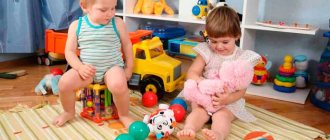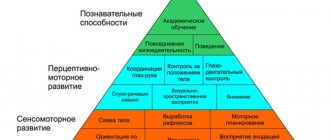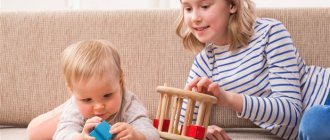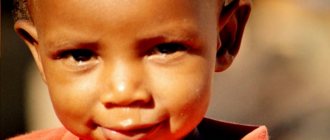It is a widely known fact that developing fine motor skills in a baby’s hands is very important. Precise, coordinated movements of the hands and fingers are necessary for a child to function fully: to write, draw, dress, and perform many everyday activities. In addition, scientists have long established that the development of fine motor skills of the hands has a beneficial effect on the development of a child’s speech. This is due to the fact that in the brain the nerve centers responsible for the movements of the fingers and hands are in close proximity to the areas of the brain responsible for the development of speech. Therefore, when the motor center is stimulated, the speech center begins to activate.
So how to develop fine motor skills? The following training options are used for this:
- games with small objects (beads, laces, locks, etc.);
- finger games accompanied by funny rhymes or songs;
- finger massage,
- drawing;
- modeling
In today's article I would like to bring to your attention several games with small objects to train the motor skills of your baby's fingers, most of them are easy to do with your own hands. The games are designed for children aged 1 year and older. Watch the second part of the games here:
GAMES TO DEVELOP FINE MOTOR SKILLS WITH A CHILD FROM 1 YEAR OLD. PART 2
So let's get started
What are fine motor skills
The ability to perform precise movements of the fingers and toes in babies is often called dexterity. After birth, the baby already shows signs of fine motor skills when he tenaciously grabs his mother’s finger with his little hand. With age, such actions manifest themselves more consciously: the baby begins to grab toys, cling to the back of the crib to get up, etc. Writing, modeling and drawing skills in a preschool child and student are also included in the concept of fine motor skills of the fingers.
From the moment of birth, the baby’s nervous, skeletal and muscular systems coordinate the development of his fine motor skills. Having observed the dynamics of changes in the motor actions of the baby’s fingers and toes, one can see how closely it is related to his overall development. Even in infancy, the child, moving his arms and wiggling his fingers, carefully watches them. At this time, his vision, attention, perception and memory work. Over time, thanks to memorization, the baby learns to control the movements of his hands.
A baby's fine motor skills do not develop very quickly, especially in the first months after birth. She, like a sponge, absorbs and stores in the corners of her memory everything that will be useful to her later: reach for an object, grab it tightly with her fingers and even her palm, pull it to her face, eyes, even taste it (especially at the time of teething). This is only the first experience, but it is very valuable for the baby. He will master complex actions closer to a year.
Another very important feature of children's fine motor skills is their close connection with speech. This is explained by the close location of the motor and speech centers in the brain. If development proceeds harmoniously, then a baby with active fine motor skills begins to speak quite early.
Advice. This means that from the first days of a baby’s life it is necessary to pay attention to the functioning of his musculoskeletal system, especially his arms and legs.
Development of fine motor skills in a baby
Finger games
Finger games occupy an important place in the formation of children's motor skills. You can practice them from the birth of your child. Make circular movements, massaging your baby's fingers, and as he grows, he will move them independently.
It is allowed to start finger massage before the child is 6 months old, and at one year the parents act as an instructor. A one-year-old baby performs characteristic movements in unison with the rhythm of a poem or song, claps his hands, and repeats exercises after mom or dad. At this age, it is not difficult for a toddler to clench his palms into a fist and close his fingers. One of the varieties of such games is finger steps.
With a child of three years of age and older, you can organize a real shadow theater. Buttons, beads, nuts and other objects are also used for finger games.
Problems with poor development of fine motor skills
Scientists studying the physiology of children have proven the inextricable connection between speech and motor skills. The fact that there is a relationship between hands and speaking is evidenced by examples of oral folk art (the nursery rhymes “The White-sided Magpie”, “Ladushki”, “The Finger Boy”). They reflected the centuries-old observations of our ancestors, who also noticed this connection.
Simple exercises to develop motor skills
The logical conclusion is that children with disabilities often cannot independently perform actions where they need to use their hands and fingers: holding a spoon or pencil, getting dressed or undressing, fastening buttons or tying shoelaces. This problem of underdeveloped fine motor skills is directly related to disorders in brain development.
For your information. A whole system of special exercises, educational games, and massage has been developed that will tell you how to develop fine motor skills in a child.
Modeling for the development of tactile sensations
Plasticineography is actively used in preschool and school institutions; it is an effective method for developing motor skills and stimulating thought processes at home. Making plasticine figures with children is exciting and at the same time useful.
Plasticineography has an alternative in the form of modeling from salt dough, which is suitable for very young children. This is a natural, and therefore safe, material that contains only three ingredients: water, flour and salt. Modeling supports sensorimotor development in children.
Fine motor development calendar
Psychomotor development of a child in the first months of life
The brain, speech organs (lips, tongue and lower jaw) and movements of the fingertips are interconnected. If a child exhibits lethargy, uncertainty, and stiffness in the actions of his hands and fingers, then, as a rule, his speech and writing will lag behind at school age.
To avoid this, there are special calendars for the physiological development and behavioral skills of a baby from birth to 4-5 years and older. Some of them help to identify whether the development of fine motor skills is impaired, and also offer simple test exercises (diagnostic). Others list the actions that children should be able to perform at a certain time period, for example, during the first month, the first year (monthly), from 1 year to 5-6 years. Each calendar includes features of behavioral skills at a specific age.
Such calendars help to understand how to develop a child’s fine motor skills. Below is an example of a table for the development of a child’s finger motor skills from birth to age 6. Of course, not all activities are included in this calendar, but it can give a general schematic picture of the dynamics of the formation of fine motor skills.
Fine motor development calendar
| Age | Fine motor skills |
| 0-4 months | The child learns to move his arms and legs, develops reflexive grasping movements, and turns his head towards his mother’s voice. |
| 4-12 months | Can hold an object with one hand, examine it, reach, take, transfer from hand to hand. He can kick a ball with his foot, hold a spoon with his hand and bring it to his mouth. |
| 1-2 years | Sits confidently and plays with both hands. Holds a pencil or spoon with the whole hand, fingers work actively. Can draw circles and lines, break plasticine, and crush it with his fingers. |
| 2-3 years | Determined with a dominant handle (“right-handed” or “left-handed”). He begins to hold a pencil with his fingers and come up with drawings on his own. Learns to cut a sheet of paper with scissors. When sculpting, the palms and fingers are used. Confidently makes mosaic drawings or puts together simple puzzles. |
| 3-4 years | By the age of 4, he holds a pencil with three fingers. Creates complex drawings, sometimes even copying them from books. Cuts with scissors in a straight line more confidently and accurately. He sculpts animal figures and objects with his fingers. |
| 4-5 years | Begins to draw and color pictures confidently. Can cut squares and circles. |
| 5-6 years | All acquired fine motor skills are improved, preparing the baby for school. |
Wonderful songs
Music is power!.. The lullabies that mother sings are special, so dear and melodic. They are remembered forever. Your child is a grateful and inspired appreciator of your talent, regardless of the extent to which your singing abilities are expressed. Sing to your little one and your grown son or daughter!
Find a song you like and sing it together, teach your child rhythm, melody, and lines of poetry. Subsequently, you will have a wonderful musical duet. And also make a small, fluffy animal, for example, a lamb (or other pet). After all, little lambs love it when little children sing to them, then they protect their sleep and give them fabulous dreams. Draw the outlines of the animals on paper or print a picture and, using medical cotton wool and glue, make fluffy “woolen” curls, and then glue them to the image. Mom’s role is a moderator of the creative process, step-by-step instructions and a sponsor of a good mood. The result is a small masterpiece of a dear person in the world! Congratulations! You did it!
We all come from childhood! From the country of happiness, serene joys, little whims, whims, sweets and sincere smiles. And in each of us there lived in our souls a traveler, an innovator, a pioneer and a tireless traveler with an interesting mission called “My Bright Life”. How much strength, energy, children's inventions and fantasies are worth small discoveries. Now, when we become parents, caring mothers and fathers, we try to be worthy, all-knowing and wise mentors of their small and such an interesting world. Let's try to try on the role of an interesting, energetic, all-understanding guide, a tour guide in the country of Childhood for our sweet angels!
When to start working with your baby
Leukocytes in the stool of a child under one year old - the norm, reasons for the increase
There is no point in talking about at what age to start classes for the development of motor skills, because the baby is engaged in this from the first days of life. At first, his movements are chaotic, his fingers clench and open impulsively. Already in the second month, you can help the baby develop grasping movements (give your finger, a round ring rattle). Only by 3-4 months, when the child begins to concentrate his attention and gaze on objects, toys and arms or legs, can you help him. How to conduct these trainings to improve a child's fine motor skills?
For the effectiveness and benefit of classes, parents must follow several rules:
- conducting them is interesting;
- emotions are only positive, the voice is quiet, calm;
- training should be short so as not to tire the baby;
- praise, even a baby (he will feel it by the intonation of his voice);
- conduct classes systematically.
Only by arming yourself with these simple requirements and fulfilling them, you can successfully conduct such classes at home.
Training exercises for the development of children's fine motor skills
Diagnostics
To determine motor development disorders, diagnostics are required. A specialist will determine its exact results, but parents can assess the situation on their own at home. To do this, you need to unobtrusively ask the child to perform exercises of this type:
- read a fairy tale, making simple movements with your hands, and then invite the child to repeat it;
- extend both arms in front of the chest, clench one palm into a fist, slowly change the position of the hands;
- exercises for fingers: the child takes steps with the middle and index fingers;
- alternately bend the fingers on the upper limbs and straighten them in the reverse order;
- connect your fingers, depicting the beak of a bird, do the exercise on both hands in turn;
- disassemble the pyramid and ask the child to assemble it themselves;
- offer to draw a copy of the house;
- trace the drawing along the dotted lines;
- decorate the figure without protruding beyond the contours.
Children 3 (three) years old are allowed to perform 30% or more of the exercises listed above. A five-year-old child should do 80-90% of the tasks. At lower scores, special training is required to develop fine motor skills.
Where to start developing fine motor skills in children
How can you tell if your baby is developing fine motor skills? When parents see that their child can grasp objects not only with a full palm, but also with two or three fingers, this means that motor skills are well developed. There is no need to stop, you need to continue training with your baby and improve the motor activity of his limbs.
All developmental activities can be divided into small groups. Exercises with infants can begin with a massage of the arms, legs and fingers. Infants of the first two months need to massage their feet, legs and palms with soft rubbing movements. Each finger can be massaged separately. This massage will improve blood circulation in the extremities.
Advice. For babies over 2 months old, play exercises “Ladushki” and “Magpie-Crow” are recommended. For children at six months old, the tasks become more complicated: you can give them paper, they really like to tear it.
Finger massage
Toys for developing fine motor skills
To develop motor activity, both gross and fine, you can use toys. The toy industry presents its products to customers in a large assortment.
How to choose the “right” toys for developing motor skills? Educational games such as mosaics, cubes and pyramids, construction sets and puzzles are perfect for this. Now more and more new models of “old” fun are appearing on the shelves:
- Sling beads (knitted beads that fit in a child’s palm);
- Textured rattles (from various materials);
- Soft books, most often made of fabric;
- Developmental panels with buttons, latches, etc. (for researchers);
- Sorters (a cube with holes for figures) and nesting dolls.
Sorting machine for developing fine motor skills
Gymnastics for small fingers
Soviet teacher V. Sukhomlinsky said that “the child’s mind is at his fingertips.” If this is so, then it is simply necessary to develop it from infancy through exercises and finger games.
How to develop hand motor skills in a small child? There are several exercises that will help activate the movements of your arms and fingers:
- "Little man." Take the child’s index finger in your hands, press it on parts of the body, saying: “Dot, dot, cucumber,” etc.
- "Fingers." Flexion and extension of fingers and toes.
- "Wall". Children's rhyme "Wall, wall, ceiling, two steps, ring - bell!" becomes an exercise. (Wall - cheeks, ceiling - forehead, steps - lips, nose - bell).
Gymnastics for the development of children's fingers has more than a dozen options. They can be changed or alternated daily.
Finger gymnastics
Games to develop fine motor skills in children under 1 year old
There are a lot of games that answer the question “How to develop motor skills in a child?” These include activities with small objects that are easy to find at home: buttons, cereals, small stones or beads. Plasticine is an excellent material for developing fine motor skills. You can come up with a lot of games for children from available items (“Peel an egg or an orange”, “Unscrew or tighten the lid”, “Unfasten or fasten a button on a doll’s dress”). It all depends on the imagination and desire of the parents.
Methodological manuals, video materials, articles will be good helpers in conducting various trainings, classes and exercises to improve the health and general physical and intellectual development of the child. Only a great desire of parents to help the baby develop can create a miracle.
General tips and tricks
- It is better to conduct developmental classes in the first half of the day and only in a good mood of both (!) participants;
- Your task is to interest the child;
- do not overload your child with the duration of the lesson (it is recommended to spend up to 15 minutes a day on motor skills) due to the fact that it is difficult for children to concentrate on one thing for a long time;
- rejoice in successes and support in failures;
- be patient, because you are already a Sorceress, and your baby is just learning the magic of life;
- learn to quickly switch the child’s attention after the lesson is finished (because some kids insistently demand that the magic continue);
- let interesting activities become a useful habit for you every day, let your child look forward to this moment.
Subsequently, you will have your own adjustments or new versions of tasks, but if you didn’t know where to start and how to develop this very motor skill, then please read!










